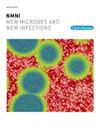Mission of polio eradication in Pakistan- a review on challenges and future recommendations
IF 5.4
Q2 INFECTIOUS DISEASES
引用次数: 0
Abstract
Poliomyelitis, commonly known as “polio” is a paralytic and perilous disease caused by the poliovirus. Due to its highly contagious nature, the virus was a challenge to the world in the late 1980s. Since 1988, the collective work of the Global Polio Eradication Initiative (GPEI), Centre for Disease Control and Prevention (CDC), and World Health Organization (WHO) through immunizations, communication awareness, and monitoring have helped the world exonerate polio. This article aims to review on challenges and future recommendations for polio eradication in Pakistan.
The mission of polio-free Pakistan was Herculean. It confronted enormous challenges in different ways but came out with positive results. In 2019, with only two remaining polio-endemic countries, Pakistan and Afghanistan, GPEI launched an “Endgame strategy 2019–2023,” aiming to eradicate polio globally, focusing on polio-endemic countries. The plan emphasizes the early detection of polio cases for complete eradication and to restrict the spread of polio. Pakistan has achieved a milestone in combating polio despite having a web of factors that have thwarted Pakistan's polio eradication efforts, but this is not the end. The struggle continues until we get an internationally verified certification of a polio-free nation; WHO has designed a multidisciplinary strategy for 2022–2026 to end this polio.
巴基斯坦消灭脊髓灰质炎任务-对挑战和未来建议的审查
脊髓灰质炎,俗称“脊髓灰质炎”,是一种由脊髓灰质炎病毒引起的麻痹性危险疾病。由于其高度传染性,该病毒在20世纪80年代后期对世界构成了挑战。自1988年以来,全球根除脊髓灰质炎行动(GPEI)、疾病控制和预防中心(CDC)和世界卫生组织(世卫组织)通过免疫、宣传和监测的集体工作,帮助世界免除了脊髓灰质炎。本文旨在回顾巴基斯坦消灭脊髓灰质炎的挑战和未来建议。巴基斯坦无脊髓灰质炎的使命是艰巨的。它以不同的方式面对巨大的挑战,但取得了积极的成果。2019年,在脊髓灰质炎流行国家仅剩巴基斯坦和阿富汗两个之际,GPEI启动了“2019 - 2023年末期战略”,旨在以脊髓灰质炎流行国家为重点,在全球范围内根除脊髓灰质炎。该计划强调及早发现脊髓灰质炎病例,以彻底根除并限制脊髓灰质炎的传播。尽管存在一系列阻碍巴基斯坦根除脊髓灰质炎努力的因素,但巴基斯坦在抗击脊髓灰质炎方面取得了里程碑式的成就,但这并不是结束。斗争将继续下去,直到我们获得国际上核实的无脊髓灰质炎国家的认证;世卫组织为终结这一脊灰制定了2022-2026年多学科战略。
本文章由计算机程序翻译,如有差异,请以英文原文为准。
求助全文
约1分钟内获得全文
求助全文
来源期刊

New Microbes and New Infections
Medicine-Infectious Diseases
CiteScore
10.00
自引率
2.50%
发文量
91
审稿时长
114 days
 求助内容:
求助内容: 应助结果提醒方式:
应助结果提醒方式:


